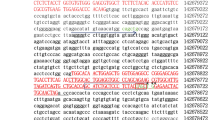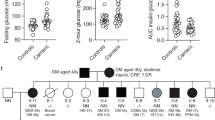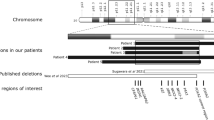Abstract
The homeodomain protein IPF1 (also known as IDX1, STF1 and PDX1; see Methods) is critical for development of the pancreas in mice and is a key factor for the regulation of the insulin gene in the β-cells of the endocrine pancreas1–6. _targeted disruption of the Ipf1 gene encoding IPF1 in transgenic mice results in a failure of the pancreas to develop (pancreatic agenesis)4–7. Here, we report the identification of a single nucleotide deletion within codon 63 of the human IPF1 gene (13q12.1) in a patient with pancreatic agenesis. The patient is homozygous for the point deletion, whereas both parents are heterozygotes for the same mutation. The deletion was not found in 184 chromosomes from normal individuals, indicating that the mutation is unlikely to be a rare polymorphism. The point deletion causes a frame shift at the C-terminal border of the transactivation domain of IPF1 resulting in the translation of 59 novel codons before termination, aminoproximal to the homeodomain essential for DNA binding. Expression of mutant IPF1 in Cos-1 cells confirms the expression of a prematurely terminated truncated protein of 16 kD. Thus, the affected patient should have no functional IPF1 protein. Given the essential role of IPF1 in pancreas development, it is likely that this autosomal recessive mutation is the cause of the pancreatic agenesis phenotype in this patient. Thus, IPF1 appears to be a critical regulator of pancreas development in humans as well as mice.
This is a preview of subscription content, access via your institution
Access options
Subscribe to this journal
Receive 12 print issues and online access
We are sorry, but there is no personal subscription option available for your country.
Buy this article
- Purchase on SpringerLink
- Instant access to full article PDF
Prices may be subject to local taxes which are calculated during checkout
Similar content being viewed by others
References
Miller, C.P., McGehee, R. & Habener, J.F. IDX-1: a new homeodomain transcription factor expressed in rat pancreatic islets and duodenum that transactivates the somatostatin gene. EMBO J. 13, 1145–1156 (1994).
Leonard, J. et al. Characterization of somatostatin transactivating factor-1, a novel homeobox factor that stimulates somatostatin expression in pnacreatic islet cells. Mol. Endocr. 7, 1275–1283 (1993).
Ohlsson, H., Karlsson, K. & Edlund, T. IPF1, a homeodomain-containing transactivator of the insulin gene. EMBO J. 12, 4251–4259 (1993).
Jonnson, J., Carlsson, L., Edlund, T. & Edlund, H. Insulin-promoter-factor 1 is required for pancreas development in mice. Nature 371, 606–609 (1994).
Peshavaria, M. et al. XIHBox 8, an endoderm-specific Xenopus homeodomain protein, is closely related to a mammalian insulin gene transcription factor. Mol. Endocr. 8, 806–816 (1994).
Peers, B., Leonard, J., Sharma, S., Teitelman, G. & Montminy, M. Insulin expression in pancreatic islet cells relies on cooperative interactions between the helix loop helix factor E47 and the homeobox factor STF-1. Mol. Endocr. 8, 1798–1806 (1994).
Offield, M.F. et al. PDX-1 is required for pancreatic outgrowth and differentiation of the rostral duodenum. Development 122, 983–995 (1996).
Wright, N.M., Metzger, D.L., Borowitz, S.M. & Clarke, W.L. Permanent neonatal diabetes mellitus and pancreatic exocrine insufficiency resulting from congenital pancreatic agenesis. Am. J. Dis. Child. 147, 607–609 (1993).
Howard, C.P. et al. Long-term survival in a case of functional pancreatic agenesis. J. Pediat. 97, 786–789.(1980).
Widnes, J.A. et al. Permanent neonatal diabetes in an infant of an insulin-dependent mother. J. Pediat. 100, 926 (1982).
Lemons, J.A., Ridenour, R. & Orsini, E.N. Congenital absence of the pancreas and intrauterine growth retardation. Pediatrics 64, 255–257.(1979).
Mehes, K. & Vamosk, G.M. Agenesis of pancreas and gallbladder in infant of incest. Acta Paediat. Acad. Sci. Hung. 17, 175–176 (1976).
Dourov, N. & Buyl-Strouvens, M.L. Agensie du pancreas. Arch. Fr. Pediat. 26, 641–650 (1969).
Sherwood, W.G., Chance, G.W. & Hill, D.E. A new syndrome of pancreatic agenesis. The role of insulin and glucagon in somatic and cell growth. Pediat Res. 8, 360 (1995).
Stoffel, M. et al. Localization of human homeodomain transcription factor insulin promoter factor (IPF-1) to chromosome band 13q 12.1. Genomics 28, 125–126.
Inoue, H. et al. Isolation, characterization, and chromosomal mapping of the human insulin promoter factor 1 (IPF-1) Gene. Diabetes 45, 789–794 (1996).
Peers, B., Sharma, S., Johnson, T., Kamps, M. & Montminy, M. The pancreatic islet factor STF-1 binds cooperatively with Pbx to regulatory element in the somatostatin promoter: importance of the FPWMK motif and of the homeodomain. Mol. Cell. Biol. 15, 7091–7097 (1995).
Lu, M., Miller, C.P. & Habener, J.F. Functional regions of the homeodomain protein IDX-1 required for transactivation of the rat somatostatin gene. Endocrinology 137, 2959–2967 (1996).
Carroll, P.B., Finegold, D.N., Becker, D.J., Locker, J.D. & Drash, A.L. Hypoplasia of the pancreas in a patient with type I diabetes mellitus. Pancreas 7, 21–25 (1992).
Dodge, J.A. & Laurence, K.M. Congenital absence of the islets of Langerhans. Arch. Dis. Child. 52, 411–413 (1977).
Winter, W.E. et al. Congenital pancreatic hypoplasia: a syndrome of exocrine and endocrine pancreatic insufficiency. J. Pediat. 109, 465–468 (1986).
Sharma, A., Olson, L.K., Robertson, R.P. & Stein, R. The reduction of insulin gene transcription in HIT-T15 β cells chronically exposed to high glucose concentration is associated with the loss of RIPE3b1 and STF-1 transcription factor expression. Molec. Endocr. 9, 1127–1134 (1995).
Olson, L.K. et al. Reduction of insulin gene transcription in HIT-T15 β cells chronically exposed to high glucose concentration is associated with the loss of STF-1 transcription factor expression. Proc. Natl. Acad. Sci. U.S.A. 92, 9127–9131 (1995).
Sambrook, J., Fritsch, E.F. & Maniatis, T., Cloning: A Laboratory Manual (Cold Spring Harbor Laboratory Press, New York, 1989).
Wood, W.I., Gtischier, J., Lasky, L.A. & Lawn, R.M. Base composition-independent hybridization in tetramethylammonium chloride: a method for oligonucleotide screening of highly complex gene libraries. Proc. Natl. Acad. Sci. USA 82, 1585–1588 (1985).
Chen, W.-J., Andes, D.A., Goldstein, J.L., Russel, D.W. & Brown, M.S. cDNA cloning and expression of the peptide-binding (3 subunit of rat p21ras farnesyl transferase, the counterpart of yeast DPR17RAM1. Cell 66, 327–334 (1991).
Ausubel, F.M. et al. Current Protocols in Molecular Biology (John Wiley & Sons, New York, 1995).
Schreiber, E., Matthias, P., Mueller, M.M. & Schaffner, W. Rapid detection of octamer binding proteins with “miniextracts” from a small number of cells. Nucl. Acid. Res. 17, 6419 (1989).
Ron, D. & Habener, J.F. CHOP, a novel developmentally regulated nuclear protein that dimerizes with transcription factors C/EBP and LAP and functions as a dominant-negative inhibitor of gene transcription. Genes Dev. 6, 439–453 (1992).
Author information
Authors and Affiliations
Rights and permissions
About this article
Cite this article
Stoffers, D., Zinkin, N., Stanojevic, V. et al. Pancreatic agenesis attributable to a single nucleotide deletion in the human IPF1 gene coding sequence. Nat Genet 15, 106–110 (1997). https://doi.org/10.1038/ng0197-106
Received:
Accepted:
Issue Date:
DOI: https://doi.org/10.1038/ng0197-106
This article is cited by
-
Monogenic diabetes
Nature Reviews Disease Primers (2023)
-
Evidence from oyster suggests an ancient role for Pdx in regulating insulin gene expression in animals
Nature Communications (2021)
-
CRISPR-based genome editing in primary human pancreatic islet cells
Nature Communications (2021)



